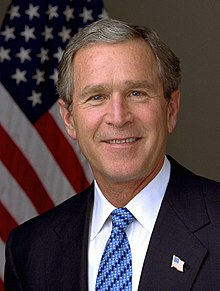
Back رئاسة جورج بوش الابن Arabic Προεδρία του Τζορτζ Γ. Μπους Greek Presidencia de George W. Bush Spanish Présidence de George W. Bush French George W. Bush kabinetje Hungarian Presidenza di George W. Bush Italian George W. Bushs regjering NB د جورج ډبليو بوش ولسمشري Pashto/Pushto Presidência de George W. Bush Portuguese Президентство Джорджа Вокера Буша Ukrainian
 | |
| Presidency of George W. Bush January 20, 2001 – January 20, 2009 | |
| Cabinet | See list |
|---|---|
| Party | Republican |
| Election | |
| Seat | White House |
|
| |
| Archived website Library website | |
| ||
|---|---|---|
|
Business and personal
46th Governor of Texas 43rd President of the United States
Tenure Presidential campaigns  |
||
George W. Bush's tenure as the 43rd president of the United States began with his first inauguration on January 20, 2001, and ended on January 20, 2009. Bush, a Republican from Texas, took office following his narrow electoral college victory over Democratic incumbent vice president Al Gore in the 2000 presidential election. Four years later, in the 2004 presidential election, he narrowly defeated Democratic nominee John Kerry, to win re-election. Bush served two terms and was succeeded by Democrat Barack Obama, who won the 2008 presidential election. He is the eldest son of the 41st president, George H. W. Bush.
A decisive event reshaping Bush's administration were the September 11, 2001 terrorist attacks. In its aftermath, Congress created the United States Department of Homeland Security and Bush declared a global war on terrorism. He ordered an invasion of Afghanistan in an effort to overthrow the Taliban, destroy al-Qaeda, and capture Osama bin Laden. He also signed the controversial Patriot Act in order to authorize surveillance of suspected terrorists. In 2003, Bush ordered an invasion of Iraq, alleging that the Saddam Hussein regime possessed weapons of mass destruction. Intense criticism came when neither WMD stockpiles nor evidence of an operational relationship with al-Qaeda were found. Before 9/11, Bush had pushed through a $1.3 trillion tax cut program and the No Child Left Behind Act, a major education bill. He also pushed for socially conservative efforts, such as the Partial-Birth Abortion Ban Act and faith-based welfare initiatives. Also in 2003, he signed the Medicare Prescription Drug, Improvement, and Modernization Act, which created Medicare Part D.
During his second term, Bush reached multiple free trade agreements and successfully nominated John Roberts and Samuel Alito to the Supreme Court. He sought major changes to Social Security and immigration laws, but both efforts failed. The wars in Afghanistan and Iraq continued, and in 2007 he launched a surge of troops in Iraq. The Bush administration's response to Hurricane Katrina and the dismissal of U.S. attorneys controversy came under attack, with a drop in his approval ratings. A global meltdown in financial markets dominated his last days in office as policymakers looked to avert a major economic disaster, and he established the Troubled Asset Relief Program (TARP) to buy toxic assets from financial institutions.
At various points in his presidency, Bush was among both the most popular and unpopular presidents in U.S. history. He received the highest recorded approval ratings in the wake of the September 11 attacks, but also one of the lowest such ratings during the Iraq War and 2007–2008 financial crisis. Although public sentiment of Bush has improved since he left office, his presidency has generally been rated as below-average by scholars.[1]
- ^ "All ranking and Tables" (PDF). 2022.


